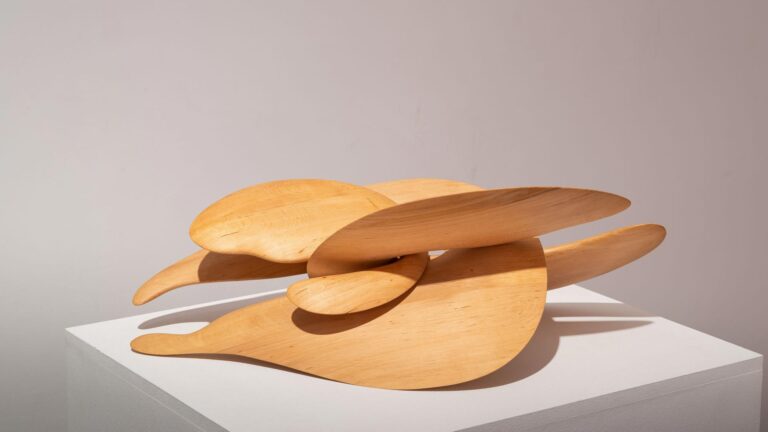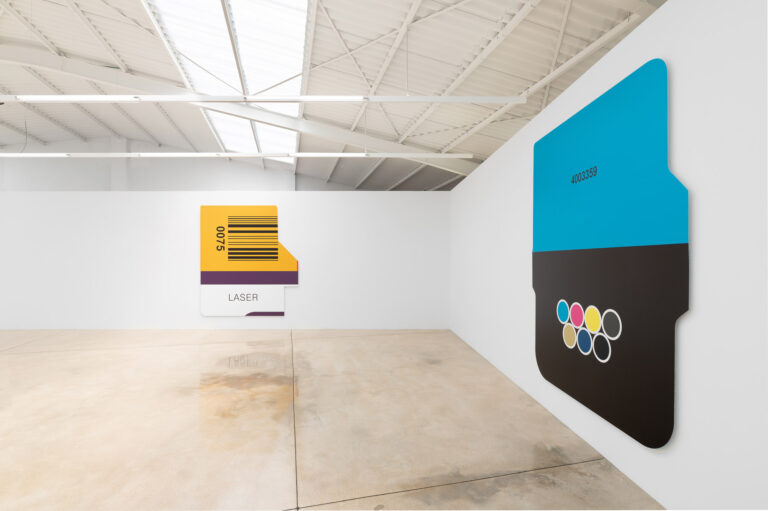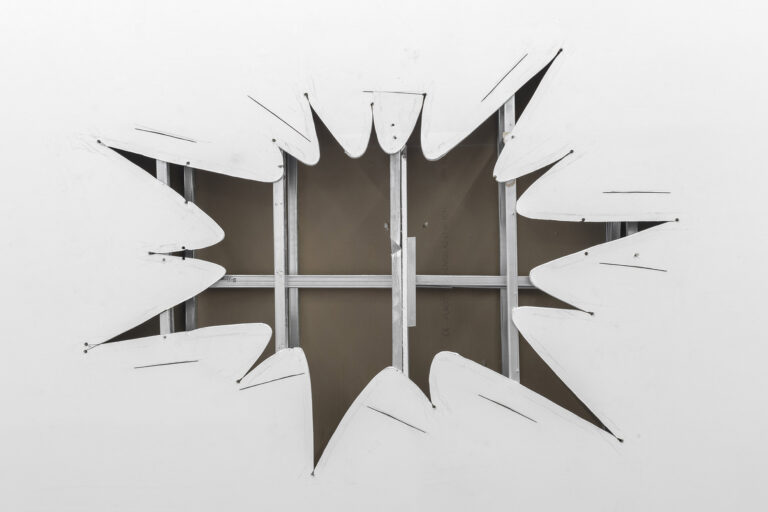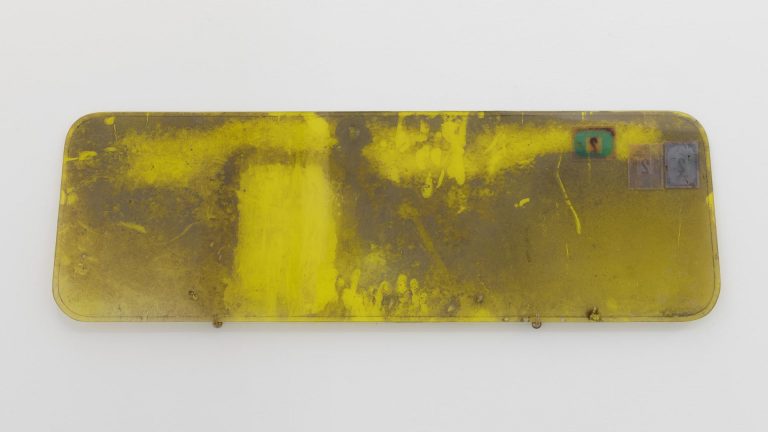Artist: Vivian Suter
Curated by: Manuel Borja-Villel
Venue: Museo Nacional Centro de Arte Reina Sofía, Palacio de Velázquez, Madrid, Spain
Date: June 25, 2021 – May 2, 2022
Photography: all images copyright and courtesy of the artist and ©Museo Nacional Centro de Arte Reina Sofía, Madrid
The Palacio de Velázquez in Retiro Park will host from 25 June 2021 to 2 May 2022 an exhibition devoted to Argentinian-Swiss artist Vivian Suter (Buenos Aires, 1949). Organized by Museo Reina Sofía, the exhibition will show nearly 500 paintings, from her pieces made on paper in the 80s to very recent work produced at her workshop in Panajachel, in the Guatemalan jungle.
Across her career, Suter has never strayed too far from the Basel art scene, the city that was her home between 1962 and 1982, where she studied and where she started to create her first works in the late 1960s.
In 1982 she installed her studio and home at Panajachel, on the land of an old coffee plantation surrounding Lake Atitlán, in the Guatemalan jungle. Since then, her work has evolved in an ever-closer exchange with the natural environment, reflected in frameless colourist canvases that flow profoundly with the tropical landscape immersing her place of work. Suter approaches abstract painting and artistic improvisation through the natural environment surroundings: her unframed canvases — or rather mantas — show painted forms that reference natural shapes, such as treetops, volcanic peaks or watery surfaces.
This relationship became more organic and procedural after Hurricane Stan, in 2005, and Hurricane Agatha, in 2010, with many of her pictures becoming mud-soddened, giving rise to pictorial series completed through the randomness of nature. From this point on, nature would intervene like a co-author in her works, which straddle the introspection inside her studio and the outside, permeated by wind, rain, mud and even small organisms from the surrounding jungle.
Her work can be seen as a link between two cultures. Her canvases are the product of a fusion between the western world and the Guatemalan context: different techniques, visions and ways of thinking combine through paint, canvas and nature. Unlike the classic image of the foreign artist seduced by exoticism, Suter is the sort of outsider who creates new links between disparate worldviews.
An evocative ecosystem at Palacio de Velázquez
The installation at the Palacio de Velázquez was conceived by the artist herself taking into account the architectural characteristics of this unique building. According to Vivian Souter, the idea was to make a tour in which the canvases create a livable space that surrounds the visitors.
Each canvas retains its own autonomy as an artwork while maintaining a close connection with the rest of the pieces, amounting to a kind of evocative ecosystem of climatic, sensorial and emotive experiences. On the canvases there are visible marks of the natural elements that have participated in their creation: footprints of their dogs, tree leaves, traces of water and mud or organic remains of wood.
Although the exhibition does not follow a chronological order, Suter has displayed at the left wing of the Palace her oldest paintings, from the early 80s, made on paper, variegated with paint and with a lot of color, very different and in contrast to the rest of the works in display.
During her Buenos Aires childhood, Suter liked to play hide and seek among the fabrics at the Estampería Belgrano, the family printworks. For her Reina Sofia Museum exhibition, the Palacio de Velázquez becomes a similar playground with viewers invited to lose themselves amongst the pieces, colours and textures that hang within the building’s glass and iron domes.
Vivian Suter
Born in Buenos Aires to European parents exiled four years after the Second World War, Suter went to Basel when she was 13, where she studied art. In 1981 she leaves Europe and starts a journey through North and Mesoamerica, where she finally settles. She has now spent more than thirty years working out of a studio in a town called Panajachel, in the Guatemalan jungle.
Suter’s first solo exhibition was at the Stampa gallery in Basel in 1971, and shows in other cities of Switzerland and Italy soon followed. In 1981 she took part in the group show 6 Künstler aus Basel [6 Artists from Basel], organised by the curator Jean-Christophe Ammann at the prestigious Kunsthalle Basel. However, feeling disenchanted with the art world and its social obligations, Suter then chose to depart the European scene and go travelling. Her wanderings eventually took her to Los Angeles, Mexico and, finally, Guatemala, then in the grip of civil war. Although she continued to sporadically exhibit across the continent, she remained very much under the radar until 2011, when Adam Szymczyk, then the director of the Kunsthalle Basel, decided to recreate the 1981 exhibition. After tracking Suter down and admiring the way she worked, Szymczyk invited her to exhibit at Museo Tamayo in Mexico City (Olinka, 2012) and then, a few years later, in the Kassel and Athens editions of documenta 14 (2017). Other exhibitions followed, at The Power Plant in Toronto (2018), The Art Institute of Chicago (2019), The Institute of Contemporary Art in Boston (2019), Tate Liverpool (2019) and the Camden Art Centre in London (2020).
In 2021 she was awarded the Prix Meret Oppenheim, a lifetime achievement award for artists whose work has played a key role in stimulating cultural dialogue in Switzerland and beyond.
Vivian Suter, 2021, exhibition view, ©Museo Nacional Centro de Arte Reina Sofía, Madrid
Vivian Suter, 2021, exhibition view, ©Museo Nacional Centro de Arte Reina Sofía, Madrid
Vivian Suter, 2021, exhibition view, ©Museo Nacional Centro de Arte Reina Sofía, Madrid
Vivian Suter, 2021, exhibition view, ©Museo Nacional Centro de Arte Reina Sofía, Madrid
Vivian Suter, 2021, exhibition view, ©Museo Nacional Centro de Arte Reina Sofía, Madrid
Vivian Suter, 2021, exhibition view, ©Museo Nacional Centro de Arte Reina Sofía, Madrid
Vivian Suter, 2021, exhibition view, ©Museo Nacional Centro de Arte Reina Sofía, Madrid
Vivian Suter, 2021, exhibition view, ©Museo Nacional Centro de Arte Reina Sofía, Madrid
Vivian Suter, 2021, exhibition view, ©Museo Nacional Centro de Arte Reina Sofía, Madrid
Vivian Suter, 2021, exhibition view, ©Museo Nacional Centro de Arte Reina Sofía, Madrid
Vivian Suter, 2021, exhibition view, ©Museo Nacional Centro de Arte Reina Sofía, Madrid
Vivian Suter, Untitled, 1980, courtesy the artist and galleries Karma International, Gladstone Gallery, House of Gaga, Proyectos Ultravioleta
Vivian Suter, Untitled, 1980, courtesy the artist and galleries Karma International, Gladstone Gallery, House of Gaga, Proyectos Ultravioleta
Vivian Suter, Untitled, n.d. , courtesy the artist and galleries Karma International, Gladstone Gallery, House of Gaga, Proyectos Ultravioleta
Vivian Suter, Untitled, n.d., courtesy the artist and Karma International
Vivian Suter, Untitled, n.d., courtesy the artist and Karma International
Vivian Suter, Untitled, 1980, courtesy the artist and galleries Karma International, Gladstone Gallery, House of Gaga, Proyectos Ultravioleta, photo: Flavio Karrer
Vivian Suter, Untitled, n.d., courtesy the artist and galleries Karma International, Gladstone Gallery, House of Gaga, Proyectos Ultravioleta
























